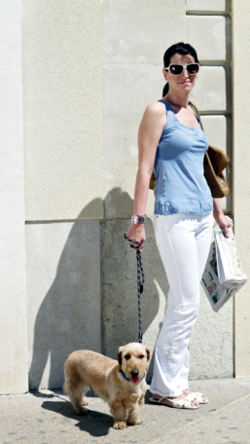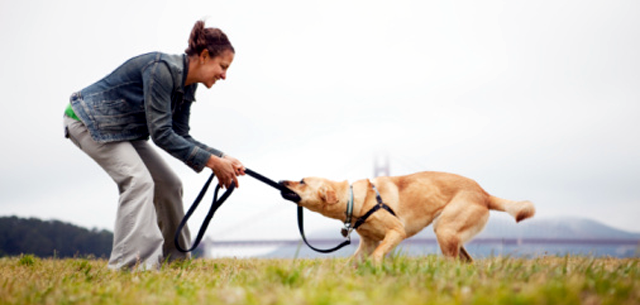Alphabets are the first step towards literacy of a kid. Prior to that he picks up whatever his mom repeats to him daily. In addition he also picks up words and expressions from other family members and siblings. He soon begins to associate the sounds from alphabets and use them for his expression. And gradually he begins to make words out of alphabets. All this is possible because we humans have a spoken language. Plus the system of learning is such that a child learns all kinds of sounds as he grows. From sounds to alphabets and from alphabets to words is a long journey.
An apparently mute animal like dog does not have a spoken language. He has the skill to learn and translate our spoken language to a command to gyrate him in to action. As already explained he learns by association of ideas taught by the master through reward and correction. It is a painstakingly slow process, but it does work.
Like we have alphabets and numbers to initiate a kid into the world of language and arithmetic, we have a system of initiating a dog in to the world of training. In the last blog we read about how to house train your dog and how to make him accept the collar and leash happily.
Despite a collar and leash training you can not keep your pup leashed all the time. And you should not expect him to sit quietly all the time. Being a pup he is a bundle of mischief, he will lie still for few minutes then come close, sniff your feet, snap at your ankle and run away or he may start chewing off the leg of the chair you are occupying. You can not go on shouting No to him all the time. The same pup if he is of a large breed grows powerful enough by four months and he can cause considerable damage if not restrained.
How to restrain the pup without making him feel that he has been shackled? The pup is in full control of the master as if held by an invisible leash. It is certainly a difficult situation yet not so difficult provided you know your dog’s psyche.
The training for restrain starts within the first three days of the arrival of the puppy. The best time to initiate the pup in this is moments before his first meal in the morning. At that time a healthy pup is ravenously hungry. Just serve his food, hold the pup (restrain) with your palm against his chest and sweetly call his name followed by a STAY. Mind you the command should be in a long drawl. Count up to five; release the pup asking him to EAT in the happiest possible tone. In the next meal increase the count to six. As you go on increasing the duration by a second per meal, you should relax your hold on his chest slowly. Soon you will find the pup stays till you command him to eat. At that stage start using your palm as a hand signal. Now when you command him to Stay, signal him to stop with your palm, like a traffic cop. In no time the pup will start stopping on seeing your hand signal.
The advantages of teaching Stay to a pup are many. For example suppose he is in to a mischief and a sharp Bozo-Stay will freeze him on the spot. Then you can go near him and pet him for being a good boy. Calling the name of the pup before issuing the actual command alerts him. But one should not use his name to punish him. Suppose he continues with his mischief, then never shout ‘Bozo, you naughty boy I will give you such a thrashing that you will repent for your life’ or just, Bozo, Bozo. All these have no impact on him. While if you just whisper his name followed by Stay, it will have a magical effect.
Teaching a pup to Stay before his meal has the added advantage that he thinks twice before stealing from your plate. He gets conditioned to eat only after you command, therefore he freezes before mouthing his choice. Amongst dogs it is a genetic trait to grab a mouthful and run. A pup trained to Stay is in fact weaned away from this trait, making lives easier.
 It must be quite clear now that dogs learn by association of ideas! If the experience is good and rewarding a dog accepts repetition happily. Training of Stay further helps in making the bond stronger between the owner and the dog. While he stays and awaits your command to eat, you may caress his body gently with your fingers all over. Always remember no animal likes his mouth or anus to be touched. In a pet dog’s life there are many occasions when these places have to be touched. While caressing you may touch him all over and also continue to do so when he starts eating his food. This experience makes him realise that your hands and fingers are meant to love him and caress him and not to hit him. From the very puppy hood as he eats, start pushing his food towards center of the bowl with fingers, this stops the spillage of food and he eats with greater speed and he gets assured that your fingers are not ‘taking away’ his food. Many people face the problem of their dog not allowing them to come near while eating. It is but natural because as an animal the dog is always chary of his food being snatched away. A pup trained in the manner explained above will get used to the fingers as he gulps his food and does not even think of attacking the master.
It must be quite clear now that dogs learn by association of ideas! If the experience is good and rewarding a dog accepts repetition happily. Training of Stay further helps in making the bond stronger between the owner and the dog. While he stays and awaits your command to eat, you may caress his body gently with your fingers all over. Always remember no animal likes his mouth or anus to be touched. In a pet dog’s life there are many occasions when these places have to be touched. While caressing you may touch him all over and also continue to do so when he starts eating his food. This experience makes him realise that your hands and fingers are meant to love him and caress him and not to hit him. From the very puppy hood as he eats, start pushing his food towards center of the bowl with fingers, this stops the spillage of food and he eats with greater speed and he gets assured that your fingers are not ‘taking away’ his food. Many people face the problem of their dog not allowing them to come near while eating. It is but natural because as an animal the dog is always chary of his food being snatched away. A pup trained in the manner explained above will get used to the fingers as he gulps his food and does not even think of attacking the master.
Please remember that this ‘invisible leash’ of Stay works only as long as the pup does not develop the ‘bolt complex’. Once he learns that he can out run you, he runs away instead of responding to your Stay. Therefore, if the pup is already more than four month old you should train him to Stay with a long leash trailing on the floor. The moment he tries to run away you can step on the leash and stop him. The pup must never realise that he can actually out run you. On the contrary he should get a feeling that you are a kind of a Superman, who can reach him anywhere, any time.
Make the bond of invisible leash strong and ultimately the dog gets so much attached to you that he always awaits your command.

 It must be quite clear now that dogs learn by association of ideas! If the experience is good and rewarding a dog accepts repetition happily. Training of Stay further helps in making the bond stronger between the owner and the dog. While he stays and awaits your command to eat, you may caress his body gently with your fingers all over. Always remember no animal likes his mouth or anus to be touched. In a pet dog’s life there are many occasions when these places have to be touched. While caressing you may touch him all over and also continue to do so when he starts eating his food. This experience makes him realise that your hands and fingers are meant to love him and caress him and not to hit him. From the very puppy hood as he eats, start pushing his food towards center of the bowl with fingers, this stops the spillage of food and he eats with greater speed and he gets assured that your fingers are not ‘taking away’ his food. Many people face the problem of their dog not allowing them to come near while eating. It is but natural because as an animal the dog is always chary of his food being snatched away. A pup trained in the manner explained above will get used to the fingers as he gulps his food and does not even think of attacking the master.
It must be quite clear now that dogs learn by association of ideas! If the experience is good and rewarding a dog accepts repetition happily. Training of Stay further helps in making the bond stronger between the owner and the dog. While he stays and awaits your command to eat, you may caress his body gently with your fingers all over. Always remember no animal likes his mouth or anus to be touched. In a pet dog’s life there are many occasions when these places have to be touched. While caressing you may touch him all over and also continue to do so when he starts eating his food. This experience makes him realise that your hands and fingers are meant to love him and caress him and not to hit him. From the very puppy hood as he eats, start pushing his food towards center of the bowl with fingers, this stops the spillage of food and he eats with greater speed and he gets assured that your fingers are not ‘taking away’ his food. Many people face the problem of their dog not allowing them to come near while eating. It is but natural because as an animal the dog is always chary of his food being snatched away. A pup trained in the manner explained above will get used to the fingers as he gulps his food and does not even think of attacking the master.
